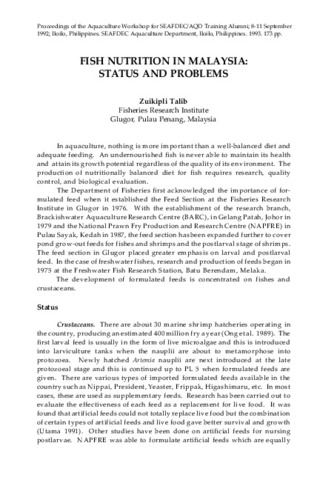A practical broodstock diet for the mangrove red snapper, Lutjanus argentimaculatus
- Global styles
- MLA
- Vancouver
- Elsevier - Harvard
- APA
- Help
Share
Abstract
A practical broodstock diet (39% protein, 8.6% lipid) was formulated for the mangrove red snapper as part of a project to ensure consistent production of good quality eggs and larvae through broodstock nutrition. Reproductive performance of mangrove red snapper broodstock fed practical diet (n=14 females) was enhanced in comparison to those fed raw fish (n=12 females). Broodstock fed practical diet had total egg production of 82.34 million from 68 spawns for two spawning seasons while broodstock fed raw fish produced 77.64 million eggs from 66 spawns. Mean percent of egg viability, hatching rates and percent of normal larvae did not vary between the two groups. However, broodstock fed the practical diet had higher mean cumulative survival rate of eggs to normal larvae (40.4%) than that of broodstock fed raw fish (35.2%). Also, survival activity index (4.08) of broodstock fed practical diet was higher than that of broodstock fed raw fish (2.97). The results clearly indicate the improvement of reproductive performance of mangrove red snapper fed practical diet. Further studies should focus on the specific nutrients that can ensure consistent production of high quality eggs and larvae of the mangrove red snapper to support its aquaculture.
Suggested Citation
Emata, A. C., & Borlongan, I. G. (2003). A practical broodstock diet for the mangrove red snapper, Lutjanus argentimaculatus. Aquaculture , 225(1-4), 83-88. https://doi.org/10.1016/S0044-8486(03)00279-5
Type
ArticleISSN
0044-8486Collections
- Journal Articles [1258]
Related items
Showing items related by title, author, creator and subject.
-
Fish nutrition in Malaysia: Status and problems
Talib, Zuikipli (Aquaculture Department, Southeast Asian Fisheries Development Center, 1993)In aquaculture, nothing is more important than a well-balanced diet and adequate feeding. An undernourished fish is never able to maintain its health and attain its growth potential regardless of the quality of its ... -
Successful use of cryopreserved oyster trocophores as a live first feed larval marine fish and invertebrates
Harvey, Brian J. (Aquaculture Department, Southeast Asian Fisheries Development Center, 1996)Trochophore-stage larvae of the Pacific oyster Crassostrea gigas were cryopreserved in bulk and stored in liquid nitrogen for periods up to two years before thawing and feeding to a variety of warmwater and coldwater larval ... -
Milkfish breeding and hatchery technology at SEAFDEC/AQD
Unknown author (Aquaculture Department, Southeast Asian Fisheries Development Center, 1999)Describes the techniques already adopted by the private sector: broodstock management, broodstock diet, commercial fry production, live transport, and larval diet. A list of AQD research publications on milkfish is included.





